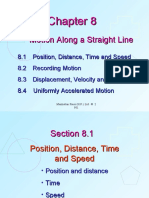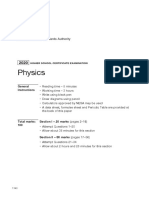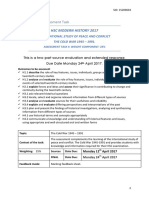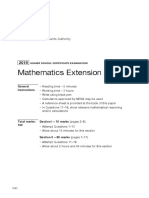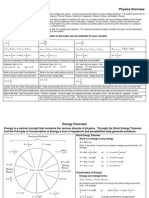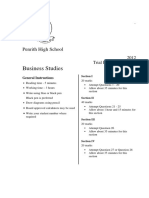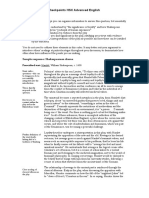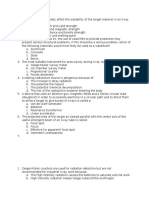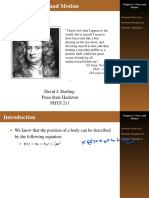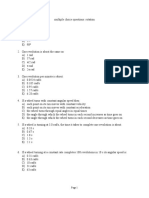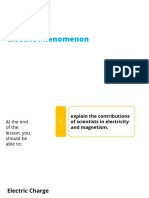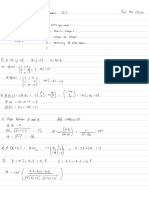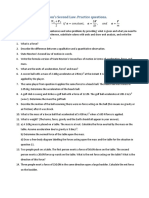Module 2: Dynamics
Force
Force
A force is a push or a pull. Force is a vector quantity and is measured in
Newtons N. Contact forces and Non – Contact Forces are two different
types.
The net force on an object is the vector sum of all individual forces. If an
object maintains constant velocity it is at equilibrium and the Fnet =0
Newton’s Laws
First Law
First Law: An object will maintain its velocity unless acted on by an
external force.
Newton’s first law is referred to as the law of inertia. Inertia is the
tendency of an object to maintain its constant velocity. Inertia α
mass
Second Law
Second Law: The acceleration is directly proportional to the net force
and inversely proportional to the mass.
F = ma
where:
F = force N
m = mass (kg)
a = acceleration (m/s2 )
Third Law
Third Law: For every action there is an equal and an opposite reaction
Module 2 Dynamics 1
� When object A exerts a force on object B, object B will exert the
same force on object A.
FAB = −FB A
Weight Force
The weight force is a force cause by gravity that acts on all objects
downwards.
W = mg
where:
W = weight N
m = mass (kg)
g = gravity (m/s2 )
Normal Force
The normal force is a force that counteracts any force that pushes an
object on a surface and always acts perpendicular to the contact surface.
FN = mg cosΘ
where:
FN = normal force N
m = mass (kg)
g = gravity (m/s2 )
Θ = angle of surface (°)
Module 2 Dynamics 2
� Frictional Force
Friction (Ff ) is the force that opposes motion. There are two different
types of friction: static friction (Fs ) and kinetic friction (Fk ). Static friction
is the minimum frictional force that must be overcome to move an object.
Kinetic friction is the frictional force to keep the object moving at a
constant velocity.
Ff = μFN
where:
Ff = frictional force N
μ = coefficient of friction
FN = normal force N
Tension
Module 2 Dynamics 3
� Tension (T ) is force transmitted along the axis of a rope and is directed
away from an object.
Energy, Work & Power
Energy
Energy is the capacity to cause change. Energy is a scalar quantity and is
measured in Joules J. There are two different types of energy: Kinetic
energy KE and Potential energy PE.
Kinetic Energy
Kinetic energy KE or K is energy associated with motion. Anything moving
has kinetic energy.
1
KE = mv 2
2
where:
KE = kinetic energy J
m = mass (kg)
v = velocity (m/s)
Module 2 Dynamics 4
� Potential Energy
Potential energy PE is the energy held by objects relative to other objects.
Gravitational potential energy U is one of the most common.
U = mgh
where:
U = gravitational potential energy J
m = mass (kg)
g = gravity (m/s2 )
h = height (m)
Module 2 Dynamics 5
� Work
Work W is the change in energy, W = ΔE. Work is a scalar quantity and is
measured in Joules J.
W = Fnet s cosΘ
where:
W = Work J
Fnet = net force N
s = displacement (m)
Θ = angle between Fnet and s
Work - Energy Theorem
Work – Energy Theorem is an important theorem, which states that the
work done on an object is equal to its change in kinetic energy. W = ΔKE
1 1
W = mv2 − mu2
2 2
where:
W = work J
m = mass (kg)
v = final velocity (m/s)
u = initial velocity (m/s)
Since the work done is the change in energy. It is possible to calculate the
work done by gravity from the gravitational potential energy formula. W =
Module 2 Dynamics 6
� ΔU
W = mgΔh
where:
W = work J
m = mass (kg)
g = gravity (m/s2 )
Δh = change in height (m)
Mechanical Energy
Mechanical energy (Em ) is the energy that an object possesses.
Mechanical energy is the sum of its kinetic energy and the potential
energies available to it. For falling objects, the mechanical energy is Em =
KE + U
1
Em = mv2 + mgh
2
where:
Em = mechanical energy J
m = mass (kg)
v = velocity (m/s)
g = gravity (m/s2 )
h = height (m)
In a system, the total mechanical energy is conservative, ΔEm = 0. This is
called the law of conservation of mechanical energy. Em(initial) =
Em(f inal)
KEinitial + Uinitial = KEf inal + Uf inal
Power
Power P is the rate at which work is done. Power is a scalar quantity and
is measured in watts W.
W
Module 2 Dynamics 7
� W
P= or P = Fnet v
t
where:
P = power W
W = work J
t = time (s)
Fnet = net force N
v = velocity (m/s)
Momentum & Impulse
Momentum
Momentum (p) is the quantity of motion in a moving body. Momentum is a
vector quantity and is measured in kilograms meter per second (kgm/s).
p = mv
where:
p = momentum (kgm/s)
m = mass (kg)
v = velocity (m/s)
Law Of Momentum
Momentum is conserved in any interaction between objects in a closed
system. This is called the law of conservation of momentum. Σpbef ore =
Σpaf ter .
m1 u1 + m2 u2 = m1 v1 + m2 v2
where:
m1 = mass of object 1 (kg)
u1 = initial velocity of object 1 (m/s)
v1 = final velocity of object 1 (m/s)
m2 = mass of object 2 (kg)
Module 2 Dynamics 8
� v1 = initial velocity of object 2 (m/s)
v1 = final velocity of object 2 (m/s)
Elastic Collision
In elastic collisions, the total kinetic energy before is equal to the total
kinetic energy after. This is known as the law of conservation of kinetic
energy. ΣKEbef ore = ΣKEaf ter .
1 1 1 1
m1 u21 + m2 u22 = m1 v12 + m2 v22
2 2 2 2
where:
m1 = mass of object 1 (kg)
u1 = initial velocity of object 1 (m/s)
v1 = final velocity of object 1 (m/s)
m2 = mass of object 2 (kg)
u2 = initial velocity of object 2 (m/s)
v2 = final velocity of object 2 (m/s)
Inelastic Collision
In inelastic collisions, the kinetic energy before is not equal to the kinetic
energy after because it is converted into other energies like heat and
sound.
When two object stick together after a collision this is known as a perfect
inelastic collision.
m1 u1 + m2 u2 = m1+2 v
where:
m1 = mass of object 1 (kg)
u1 = initial velocity of object 1 (m/s)
m2 = mass of object 2 (kg)
Module 2 Dynamics 9
� u2 = initial velocity of object 2 (m/s)
m1+2 = mass of object 1 and 2 (kg)
v = final velocity of object 1 and 2 (m/s)
It is also possible for one object to break apart into two separate objects.
This is called an explosive collision.
m1 u = m2 v2 + m3 v3
where:
m1 = mass of object 1 (kg)
u = initial velocity of object 1 (m/s)
m2 = mass of fragment 1 (kg)
v2 = final velocity of fragment 1 (m/s)
m3 = mass of fragment 2 (kg)
v3 = final velocity of fragment 2 (m/s)
Impulse
Impulse J is the change in momentum of a moving object, J = Δp.
Impulse is a vector quantity and is measured in newton second N s).
J = mv − mu or J = Fnet Δt
where:
J = impulse (N/s)
m = mass (kg)
v = final velocity (m/s)
u = initial velocity (m/s)
Fnet = net force N
Δt = change in time (s)
Force - Time Graph
Module 2 Dynamics 10
�Module 2 Dynamics 11









